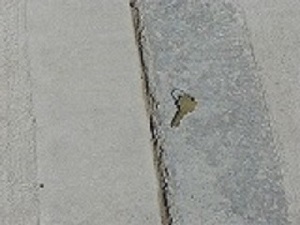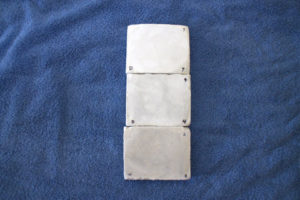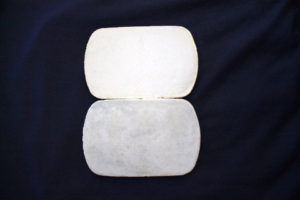One would think that when mixing white cement with white limestone aggregate (which comprises pool plaster), the final pool plaster product would always be white. But that is not always the case.
White pool plaster sometimes becomes a mottled gray (or grey) color, either immediately or a few months after the new plaster pool is filled with water. What causes that to happen?
The concrete/cement industry has determined that late hard troweling can cause cement/concrete (white or gray) surfaces to darken, mottle, and become spotted. Also, adding a high dosage of calcium chloride (CC) to cement or plaster mixes causes a darkening (graying) hue to develop.* And the combination of those two issues is very problematic.

These photos show gray concrete that has mottles and spotted due to calcium chloride and finishing issues.

Experiment Sequence 1

The above pictures of plaster coupons show varying degrees of grayness. The top left coupon was made with no calcium chloride (CC) added, and properly timed troweling. The top right coupon also had no CC added, but was late hard troweled. The bottom left coupon had 2% CC added to the mix, and was properly troweled. With the bottom right coupon, 2% CC was added, and it was late hard troweled. All were then placed in balanced water for one year.
Note the darker color of the bottom left coupon, that had 2% CC added, in comparison to the top left coupon, which had no CC added. And note the darker color of the bottom right coupon, that had 2% CC added and received only minimal late hard troweling, in comparison to the top right coupon, which had no CC added, and received four times the amount of late hard troweling.
Experiment Sequence 2

In the picture above, note that the top coupon is the whitest. That coupon had zero CC added and was properly troweled.
The middle coupon had 2% CC added, and received some late hard troweling. Neither of those coupons were placed into water.
The bottom plaster coupon had 2% CC added, received some late hard troweling, and placed in balanced water for one year. Note how the bottom coupon darkened even more after being submerged in water.
Experiment Sequence 3
White Plaster Can Also Turn Blotchy
Both white pool plaster coupons below have been in water for one year. Sometimes the water was slightly aggressive (negative Langelier Saturation Index, or LSI), and sometimes the water was slightly scale forming (positive LSI).
The top coupon was formed with only one percent calcium chloride (CC) added to the mix, and was properly troweled. It remained a “uniform white” the entire time.
The bottom coupon had 3% calcium chloride (CC) added, was late hard troweled, and also received some wet (water) troweling late in the process.

Note the light and darker color contrast of the bottom coupon creating a “blotchy” appearance. The darker areas are very dense due to the hard troweling. The lighter (white) areas and spots are due to higher water-to-cement ratio and porosity from wet troweling. Had that coupon not been troweled with water, it probably would have been more overall gray due to the high CC and late hard troweling only.
Sometimes, plasterers add too much CC to a plaster mix to speed up the hardening process and finish the pool faster. The plaster mix may harden so fast that the trowel finishers can’t keep up. If the plaster is not smooth enough, the finishers may then splash water onto the surface to rework and soften up the plaster again to get it smooth.
This experiment demonstrates that improper troweling and workmanship can create non-uniform discolorations of white pool plaster, and has nothing to do with whether the pool water was aggressive.
* Greening, N.R. and Landgren. “Surface Discoloration of Concrete Flatwork.” Portland Cement Association Publication RX203, 1966
